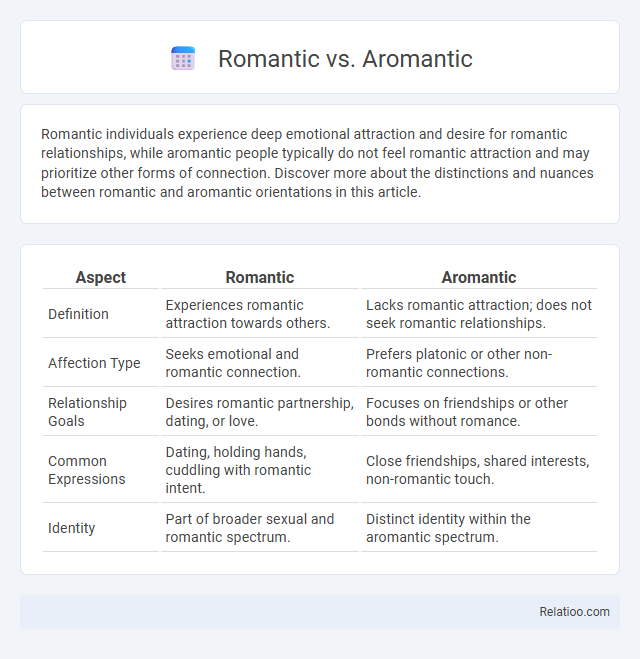Romantic individuals experience deep emotional attraction and desire for romantic relationships, while aromantic people typically do not feel romantic attraction and may prioritize other forms of connection. Discover more about the distinctions and nuances between romantic and aromantic orientations in this article.
Table of Comparison
| Aspect | Romantic | Aromantic |
|---|---|---|
| Definition | Experiences romantic attraction towards others. | Lacks romantic attraction; does not seek romantic relationships. |
| Affection Type | Seeks emotional and romantic connection. | Prefers platonic or other non-romantic connections. |
| Relationship Goals | Desires romantic partnership, dating, or love. | Focuses on friendships or other bonds without romance. |
| Common Expressions | Dating, holding hands, cuddling with romantic intent. | Close friendships, shared interests, non-romantic touch. |
| Identity | Part of broader sexual and romantic spectrum. | Distinct identity within the aromantic spectrum. |
Understanding Romantic and Aromantic Orientations
Romantic orientation defines an individual's pattern of romantic attraction toward others, independent of sexual attraction, while aromantic orientation characterizes those who experience little to no romantic attraction. Understanding these orientations helps distinguish between emotional and physical desires, emphasizing the validity of identities beyond traditional romantic norms. Recognizing the spectrum of romantic experiences fosters inclusivity and supports mental health within diverse communities.
Defining Romantic Attraction
Romantic attraction involves the desire to form an emotional and intimate bond with another person, distinct from sexual attraction which relates to physical desire. Aromantic individuals typically experience little to no romantic attraction, which does not necessarily impact their sexual orientation or capacity for deep connections. Understanding the difference between romantic attraction and sexual orientation helps clarify your identity and relationships.
What Does It Mean to Be Aromantic?
Being aromantic means experiencing little to no romantic attraction toward others, which differs from romantic orientations that describe who you may feel romantic feelings for. Unlike sexual orientation, which relates to the gender(s) you are attracted to sexually, aromanticism specifically addresses the absence or very low presence of romantic desire. Your identity as aromantic can influence how you form relationships and connect emotionally without the expectation of traditional romantic involvement.
Common Myths About Romance and Aromanticism
Common myths about romance and aromanticism often include the misconception that aromantic individuals cannot form deep or meaningful relationships, which overlooks their capacity for strong platonic bonds. Romantic orientation defines who you feel romantic attraction towards, while aromanticism specifically refers to the absence of romantic attraction, not a lack of love or connection. Understanding these distinctions challenges stereotypes and enhances awareness about the diverse ways people experience and express intimacy.
Emotional Intimacy: Romantic vs Aromantic Perspectives
Romantic individuals often seek deep emotional intimacy through romantic connections, valuing affection, bonding, and shared experiences. Aromantic people typically experience little to no romantic attraction, prioritizing platonic relationships and emotional closeness without romantic expectations. Understanding your own orientation can help clarify how you navigate emotional intimacy and build meaningful relationships aligned with your romantic or aromantic perspective.
Relationships Beyond Romance: Friendship and Companionship
Romantic orientation defines the patterns of romantic attraction individuals experience, while aromanticism characterizes those who typically do not feel romantic attraction but still seek deep connections. Relationships beyond romance, such as friendship and companionship, provide essential emotional support, intimacy, and fulfillment regardless of romantic orientation. Emphasizing the value of non-romantic bonds highlights the diverse ways people experience attachment and build meaningful interpersonal connections.
Aromanticism and Society: Navigating Expectations
Aromanticism challenges traditional societal expectations by rejecting the conventional emphasis on romantic attraction as essential for fulfillment and relationships. People identifying as aromantic often navigate social pressures by redefining connection through deep friendships and alternative forms of intimacy, fostering acceptance and understanding in diverse communities. Recognizing aromanticism expands the conversation around orientation beyond romantic attraction, highlighting the importance of validating varied emotional experiences and identities.
Representation of Aromantic Individuals in Media
Aromantic individuals are often underrepresented in mainstream media, leading to a lack of awareness and understanding about their unique experiences compared to romantic orientations such as heterosexual, homosexual, or bisexual identities. When depicted, aromantic characters are frequently portrayed with stereotypes or as side characters lacking depth, which perpetuates misconceptions and invisibility within broader LGBTQ+ narratives. Increasing authentic, nuanced portrayals of aromantic people in films, literature, and television is crucial for fostering inclusivity and validating diverse romantic orientations.
Supporting Aromantic and Romantic People
Supporting romantic and aromantic people means recognizing the validity of diverse emotional experiences and respecting individual orientations without assumptions. Your understanding fosters inclusivity by affirming that romantic attraction varies independently from sexual orientation, ensuring both romantic and aromantic identities receive equal acceptance. Providing resources and respectful language helps create safe spaces where everyone's unique romantic or aromantic feelings are validated and embraced.
Embracing Diverse Relationship Experiences
Romantic orientation describes who individuals are emotionally attracted to, while aromantic individuals experience little or no romantic attraction, highlighting the spectrum of human connection beyond traditional norms. Understanding these orientations enriches the dialogue about personal identity and fosters acceptance of diverse relationship experiences. Embracing this diversity allows people to authentically express their needs and build meaningful connections without societal pressure.

Infographic: Romantic vs Aromantic
 relatioo.com
relatioo.com